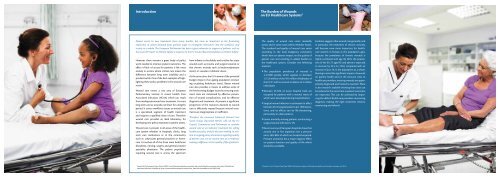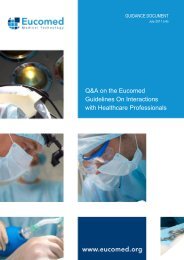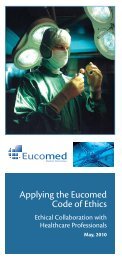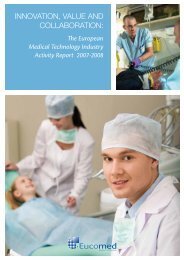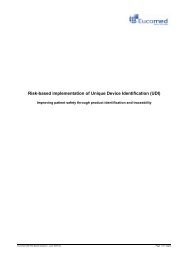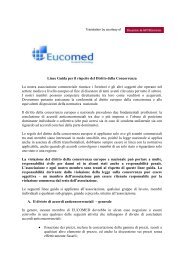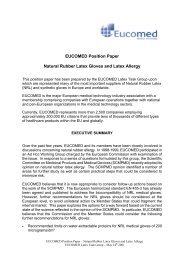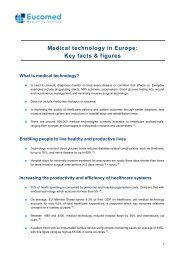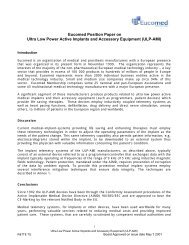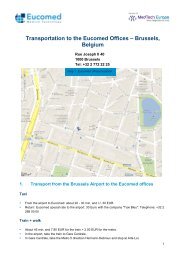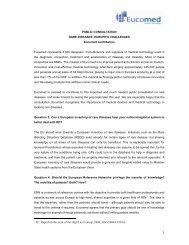The Burden of Wounds on EU Healthcare Systems - Eucomed
The Burden of Wounds on EU Healthcare Systems - Eucomed
The Burden of Wounds on EU Healthcare Systems - Eucomed
You also want an ePaper? Increase the reach of your titles
YUMPU automatically turns print PDFs into web optimized ePapers that Google loves.
Introducti<strong>on</strong><br />
<str<strong>on</strong>g>The</str<strong>on</strong>g> <str<strong>on</strong>g>Burden</str<strong>on</strong>g> <str<strong>on</strong>g>of</str<strong>on</strong>g> <str<strong>on</strong>g>Wounds</str<strong>on</strong>g><br />
<strong>on</strong> <strong>EU</strong> <strong>Healthcare</strong> <strong>Systems</strong> 2<br />
Patient access to new treatments faces many hurdles, but n<strong>on</strong>e as important as the frustrating<br />
experience <str<strong>on</strong>g>of</str<strong>on</strong>g> unmet demand from patients eager to reintegrate themselves into the workforce and<br />
society as a whole. <str<strong>on</strong>g>The</str<strong>on</strong>g> European Parliament has been a great advocate in support <str<strong>on</strong>g>of</str<strong>on</strong>g> patients such as<br />
the recent EP report <strong>on</strong> Patient Safety in resp<strong>on</strong>se to the <strong>EU</strong> Council Recommendati<strong>on</strong> <strong>on</strong> Patient Safety 1 .<br />
However, there remains a great body <str<strong>on</strong>g>of</str<strong>on</strong>g> policy<br />
work needed to improve patient outcomes. <str<strong>on</strong>g>The</str<strong>on</strong>g><br />
effect <str<strong>on</strong>g>of</str<strong>on</strong>g> lack <str<strong>on</strong>g>of</str<strong>on</strong>g> access for patients is felt most<br />
acutely in sectors where critical care means the<br />
difference between l<strong>on</strong>g term invalidity and a<br />
productive life. One <str<strong>on</strong>g>of</str<strong>on</strong>g> the best examples <str<strong>on</strong>g>of</str<strong>on</strong>g> highlighting<br />
these policy problems is the wound care<br />
sector.<br />
Wound care covers a vast area <str<strong>on</strong>g>of</str<strong>on</strong>g> European<br />
Parliamentary interest. It covers Health Care<br />
Associated infecti<strong>on</strong>s (HCAIs) which can result<br />
from inadequate wound care treatment. It covers<br />
l<strong>on</strong>g term care as wounds can fester for a lengthy<br />
period. It covers workforce issues as wound care<br />
is a specialised segment <str<strong>on</strong>g>of</str<strong>on</strong>g> health treatment<br />
and requires a qualified chain <str<strong>on</strong>g>of</str<strong>on</strong>g> care. <str<strong>on</strong>g>The</str<strong>on</strong>g>refore<br />
wound care provides an ideal laboratory for<br />
developing new policy resp<strong>on</strong>ses to patient access.<br />
Wound care is present in all areas <str<strong>on</strong>g>of</str<strong>on</strong>g> the healthcare<br />
system whether in hospitals, clinics, l<strong>on</strong>g<br />
term care instituti<strong>on</strong>s or in the community<br />
such as physicians general practices or homecare.<br />
It involves all <str<strong>on</strong>g>of</str<strong>on</strong>g> the three main healthcare<br />
disciplines, nursing, surgery and general practice<br />
speciality physicians. <str<strong>on</strong>g>The</str<strong>on</strong>g> patient populati<strong>on</strong><br />
requiring wound care is across the spectrum<br />
from infants to the elderly and is either for acute<br />
wounds such as trauma and surgical wounds or<br />
else chr<strong>on</strong>ic wounds such as bedsores(pressure<br />
ulcers) or vascular or diabetic ulcers.<br />
At the same time, the <strong>EU</strong> is aware <str<strong>on</strong>g>of</str<strong>on</strong>g> the potential<br />
budget impact <str<strong>on</strong>g>of</str<strong>on</strong>g> an ageing populati<strong>on</strong> (including<br />
escalating healthcare costs). Better wound<br />
care also provides a means to address some <str<strong>on</strong>g>of</str<strong>on</strong>g><br />
the forthcoming budget issues by ensuring treatment<br />
costs are minimised by effective preventi<strong>on</strong><br />
<str<strong>on</strong>g>of</str<strong>on</strong>g> wound complicati<strong>on</strong>s, and by effective<br />
diagnosis and treatment. At present a significant<br />
proporti<strong>on</strong> <str<strong>on</strong>g>of</str<strong>on</strong>g> the resources devoted to wound<br />
care is effectively wasted because wound treatments<br />
are inappropriate or inefficient.<br />
<str<strong>on</strong>g>The</str<strong>on</strong>g>refore, the <strong>Eucomed</strong> Advanced Wound Care<br />
Sector Group (<strong>Eucomed</strong> AWCS) calls <strong>on</strong> the <strong>EU</strong><br />
Council, Commissi<strong>on</strong> and Parliament to c<strong>on</strong>sider<br />
wound care as an indicator treatment for setting<br />
healthcare policy and for decisi<strong>on</strong> making. In relati<strong>on</strong><br />
to <strong>on</strong>going policy discussi<strong>on</strong>s regarding quality<br />
<str<strong>on</strong>g>of</str<strong>on</strong>g> patient care, we see wound care as a model for<br />
making a difference in the quality <str<strong>on</strong>g>of</str<strong>on</strong>g> life <str<strong>on</strong>g>of</str<strong>on</strong>g> patients.<br />
<str<strong>on</strong>g>The</str<strong>on</strong>g> quality <str<strong>on</strong>g>of</str<strong>on</strong>g> wound care varies markedly<br />
across and in some cases within Member States.<br />
<str<strong>on</strong>g>The</str<strong>on</strong>g> standard and quality <str<strong>on</strong>g>of</str<strong>on</strong>g> wound care varies<br />
according to the local budgetary c<strong>on</strong>straints<br />
which have an adverse impact <strong>on</strong> the quality <str<strong>on</strong>g>of</str<strong>on</strong>g><br />
patient care and resulting in added burden to<br />
the healthcare system. C<strong>on</strong>sider the following<br />
statistics:<br />
• <str<strong>on</strong>g>The</str<strong>on</strong>g> populati<strong>on</strong> prevalence <str<strong>on</strong>g>of</str<strong>on</strong>g> wounds is<br />
3-4/1000 people, which equates to between<br />
1.5-2.0 milli<strong>on</strong> <str<strong>on</strong>g>of</str<strong>on</strong>g> the 491 milli<strong>on</strong> inhabitants <str<strong>on</strong>g>of</str<strong>on</strong>g><br />
the <strong>EU</strong> 27 with an annual incidence <str<strong>on</strong>g>of</str<strong>on</strong>g> 4 milli<strong>on</strong><br />
individuals<br />
• Between 25-50% <str<strong>on</strong>g>of</str<strong>on</strong>g> acute hospital beds are<br />
occupied by patients with a wound, many <str<strong>on</strong>g>of</str<strong>on</strong>g><br />
which were developed during hospitalisati<strong>on</strong>.<br />
• Surgical wound infecti<strong>on</strong> is estimated to affect<br />
between 30-40 surgical patients per 1000 operati<strong>on</strong>s,<br />
and its effects can be life-threatening,<br />
particularly in older patients.<br />
• Excess mortality am<strong>on</strong>g patients c<strong>on</strong>tracting a<br />
surgical wound infecti<strong>on</strong> is 5%.<br />
• Recent surveys <str<strong>on</strong>g>of</str<strong>on</strong>g> European hospitals show that<br />
around <strong>on</strong>e in five inpatients has a pressure<br />
ulcer, 50%-80% <str<strong>on</strong>g>of</str<strong>on</strong>g> which are hospital-acquired.<br />
Pressure ulcerati<strong>on</strong> has a major negative effect<br />
<strong>on</strong> patient functi<strong>on</strong> and quality <str<strong>on</strong>g>of</str<strong>on</strong>g> life which<br />
should be avoidable.<br />
Evidence suggests that wound care generally, and<br />
in particular the treatment <str<strong>on</strong>g>of</str<strong>on</strong>g> chr<strong>on</strong>ic wounds,<br />
will become even more important for healthcare<br />
systems in Europe as the populati<strong>on</strong> ages,<br />
because the prevalence <str<strong>on</strong>g>of</str<strong>on</strong>g> chr<strong>on</strong>ic wounds is<br />
highly correlated with age. By 2025, the populati<strong>on</strong><br />
<str<strong>on</strong>g>of</str<strong>on</strong>g> the <strong>EU</strong> 27 aged 65 and above is expected<br />
to increase by 25.5 m (13%), compared with an<br />
increase <str<strong>on</strong>g>of</str<strong>on</strong>g> just 1% in the populati<strong>on</strong> as a whole.<br />
Bearing in mind the significant impact <str<strong>on</strong>g>of</str<strong>on</strong>g> wounds<br />
<strong>on</strong> patient health and <strong>on</strong> the resource costs to<br />
healthcare providers, ensuring wounds are appropriately<br />
diagnosed and treated is essential. <str<strong>on</strong>g>The</str<strong>on</strong>g>re<br />
is also research available showing that costs can<br />
be reduced at the same time as patient outcomes<br />
are improved. This can be achieved by improving<br />
the skills <str<strong>on</strong>g>of</str<strong>on</strong>g> health care providers c<strong>on</strong>cerning<br />
diagnosis, making the right treatment choices,<br />
m<strong>on</strong>itoring and referral.<br />
1<br />
Council <str<strong>on</strong>g>of</str<strong>on</strong>g> the European Uni<strong>on</strong> (9 June 2009), Council Recommendati<strong>on</strong> <strong>on</strong> patient safety, including the preventi<strong>on</strong> and c<strong>on</strong>trol <str<strong>on</strong>g>of</str<strong>on</strong>g> healthcare<br />
associated infecti<strong>on</strong>s. Available at: http://www.c<strong>on</strong>silium.europa.eu/uedocs/cms_data/docs/pressdata/en/lsa/108381.pdf<br />
2<br />
Posnett, J. et al, J. Wound Care (April 2009), <str<strong>on</strong>g>The</str<strong>on</strong>g> Resource Impact <str<strong>on</strong>g>of</str<strong>on</strong>g> <str<strong>on</strong>g>Wounds</str<strong>on</strong>g> <strong>on</strong> Health-care Providers in Europe, vol.18 (4).
Policy Recommendati<strong>on</strong>s<br />
<strong>Eucomed</strong><br />
Wound Care<br />
Policy Paper<br />
To this end, the <strong>Eucomed</strong> AWCS calls <strong>on</strong> the<br />
Members <str<strong>on</strong>g>of</str<strong>on</strong>g> the European Parliament and<br />
Commissi<strong>on</strong> to c<strong>on</strong>sider the following policy<br />
measures:<br />
• First, health authorities should support<br />
and promote research and exchange <str<strong>on</strong>g>of</str<strong>on</strong>g><br />
best practice, including after-care, for the<br />
treatment <str<strong>on</strong>g>of</str<strong>on</strong>g> wounds and the preventi<strong>on</strong><br />
<str<strong>on</strong>g>of</str<strong>on</strong>g> wound complicati<strong>on</strong>s. This will include<br />
gathering informati<strong>on</strong> <strong>on</strong> the prevalence<br />
<str<strong>on</strong>g>of</str<strong>on</strong>g> wounds and <strong>on</strong> current wound care<br />
practice within individual healthcare provider<br />
organisati<strong>on</strong>s and identifying methods that<br />
achieve the best results for patients based <strong>on</strong><br />
proven methods for preventi<strong>on</strong> and healing.<br />
Support through programmes such as the 7 th<br />
Research Framework programme would be<br />
critical in this regard.<br />
• Sec<strong>on</strong>d, educati<strong>on</strong> for healthcare providers<br />
<strong>on</strong> the importance <str<strong>on</strong>g>of</str<strong>on</strong>g> wound care is essential<br />
for a good quality health system, and there<br />
is a need to foster educati<strong>on</strong> and training <str<strong>on</strong>g>of</str<strong>on</strong>g><br />
healthcare workers at Member State level, with<br />
particular provisi<strong>on</strong>s for healthcare workers<br />
specialising in wound care. This means a more<br />
holistic approach to wound care as an example<br />
<str<strong>on</strong>g>of</str<strong>on</strong>g> best practice, not just narrow treatment.<br />
<str<strong>on</strong>g>The</str<strong>on</strong>g> recent Green Paper <strong>on</strong> the HealthCare<br />
workforce 3 would be an ideal forum to address<br />
the chain <str<strong>on</strong>g>of</str<strong>on</strong>g> care issue in relati<strong>on</strong> to acute care<br />
treatment settings.<br />
• Third, the results <str<strong>on</strong>g>of</str<strong>on</strong>g> seeking the methods<br />
and ways <str<strong>on</strong>g>of</str<strong>on</strong>g> treating wound care should be<br />
integrated into the review <str<strong>on</strong>g>of</str<strong>on</strong>g> availability<br />
and access to best practice treatments.<br />
Member States should review this as part <str<strong>on</strong>g>of</str<strong>on</strong>g><br />
their <strong>on</strong>going efforts to identify and promote<br />
best practice. This should include evolving best<br />
pratice standards for wound care, supported<br />
by <strong>EU</strong> programmes.<br />
Overall, central <strong>EU</strong> policy coordinati<strong>on</strong> and<br />
acti<strong>on</strong> to improve wound care access and<br />
treatment would provide an ideal test laboratory<br />
to determine the impact <str<strong>on</strong>g>of</str<strong>on</strong>g> <strong>EU</strong> policy <strong>on</strong> health<br />
outcomes.<br />
<strong>Eucomed</strong> AWCS looks forward to working with<br />
the European Parliament and Commissi<strong>on</strong> <strong>on</strong><br />
these important issues.<br />
About <strong>Eucomed</strong> Advanced<br />
Wound Care Sector Group<br />
(AWCS)<br />
<str<strong>on</strong>g>The</str<strong>on</strong>g> AWCS is a working group within <strong>Eucomed</strong>,<br />
the “Voice <str<strong>on</strong>g>of</str<strong>on</strong>g> the Medical Technology Industry in<br />
Europe”. What is unique about this sector group<br />
is the close and active cooperati<strong>on</strong> between the<br />
industry and clinicians (represented by EWMA).<br />
<strong>Eucomed</strong> represents directly and indirectly<br />
4500 designers, manufacturers and suppliers <str<strong>on</strong>g>of</str<strong>on</strong>g><br />
medical technology used in the diagnosis,<br />
preventi<strong>on</strong>, treatment and ameliorati<strong>on</strong> <str<strong>on</strong>g>of</str<strong>on</strong>g><br />
disease and disability. Small and medium sized<br />
companies make up more than 80% <str<strong>on</strong>g>of</str<strong>on</strong>g> this<br />
sector. <str<strong>on</strong>g>The</str<strong>on</strong>g> European medical technology industry<br />
invests some €5.8 billi<strong>on</strong> in R&D and employs<br />
near to 529,000 highly skilled workers. <str<strong>on</strong>g>The</str<strong>on</strong>g><br />
missi<strong>on</strong> <str<strong>on</strong>g>of</str<strong>on</strong>g> <strong>Eucomed</strong> is to improve patient and<br />
clinician access to modern, innovative and<br />
reliable medical technology.<br />
For further informati<strong>on</strong>, please c<strong>on</strong>tact<br />
About the European Wound<br />
Management Associati<strong>on</strong><br />
(EWMA)<br />
<str<strong>on</strong>g>The</str<strong>on</strong>g> overall aim <str<strong>on</strong>g>of</str<strong>on</strong>g> EWMA’s participati<strong>on</strong> in<br />
the <strong>Eucomed</strong> AWCS group is to represent the<br />
clinical voice <str<strong>on</strong>g>of</str<strong>on</strong>g> wound care to ensure that<br />
the implicati<strong>on</strong> <str<strong>on</strong>g>of</str<strong>on</strong>g> wounds from both the<br />
patient and clinician are understood. WMA<br />
is a multidisciplinary group bringing<br />
together individual clinicians as well as<br />
organisati<strong>on</strong>s interested in wound management.<br />
<str<strong>on</strong>g>The</str<strong>on</strong>g> main objectives <str<strong>on</strong>g>of</str<strong>on</strong>g> EWMA are to:<br />
• Disseminate and implement new knowledge<br />
about wound management in order to secure<br />
the best possible treatment c<strong>on</strong>diti<strong>on</strong>s<br />
throughout Europe.<br />
• Secure a c<strong>on</strong>tinued development <str<strong>on</strong>g>of</str<strong>on</strong>g> the wound<br />
management area by c<strong>on</strong>tributing to research<br />
into epidemiology, pathology, diagnosis,<br />
preventi<strong>on</strong> and management <str<strong>on</strong>g>of</str<strong>on</strong>g> wounds <str<strong>on</strong>g>of</str<strong>on</strong>g> all<br />
aetiologies.<br />
<str<strong>on</strong>g>The</str<strong>on</strong>g> activities <str<strong>on</strong>g>of</str<strong>on</strong>g> EWMA are based <strong>on</strong> a str<strong>on</strong>g<br />
collaborati<strong>on</strong> with the nati<strong>on</strong>al wound care<br />
organisati<strong>on</strong>s in Europe and other internati<strong>on</strong>al<br />
organisati<strong>on</strong>s with similar objectives.<br />
For more informati<strong>on</strong> ab out EWM A:<br />
www.ewma.org<br />
3<br />
Commissi<strong>on</strong> <str<strong>on</strong>g>of</str<strong>on</strong>g> the European Communities (10 December 2008) Green Paper <strong>on</strong> the European Workforce for Health.<br />
Available at: http://ec.europa.eu/health/ph_systems/docs/workforce_gp_en.pdf<br />
Laurence Couturier - Laurence.couturier@eucomed.be<br />
<strong>Eucomed</strong> Secretariat - www.eucomed.org<br />
Tel: +32 (0)2 772 22 12


